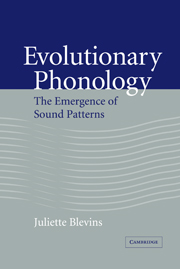7 - The evolution of geminates
Published online by Cambridge University Press: 22 September 2009
Summary
If one attempts to characterize the so-called “inner form” of language … one can only do so by tracing the origins of expressions and their basic meanings. And so I cannot conceive how one could with any hope of success think about a language without discovering at least to some extent how it came to be as it is.
Paul (1920: 21–22)Why geminates?
In addition to the distinctive features which compose speech, it is generally recognized that a distinction must be made between long and short segments in phonological representations. Long consonants are also called geminates. In this chapter, I investigate the historical origins of long or geminate consonants, and ways in which their synchronic behavior may reflect historical origins. The impetus for this study is two-fold. On the one hand, phonological theory has struggled with various aspects of geminate distribution, representation, and behavior. Geminates have been associated with special properties, including resistance to epenthesis and lenition processes, and have been problematic for theories of syllable weight. On the other hand, the neogrammarian position summarized in Paul's quote above leads us to believe that geminates with different historical origins may give rise to geminates with distinct synchronic properties. Because geminates can arise in many different ways, as I highlight below, and because their phonology has been well studied in many languages, a case study of geminate evolution can provide a basis on which to assess and compare synchronic and historical accounts of geminate phonology.
- Type
- Chapter
- Information
- Evolutionary PhonologyThe Emergence of Sound Patterns, pp. 168 - 191Publisher: Cambridge University PressPrint publication year: 2004

